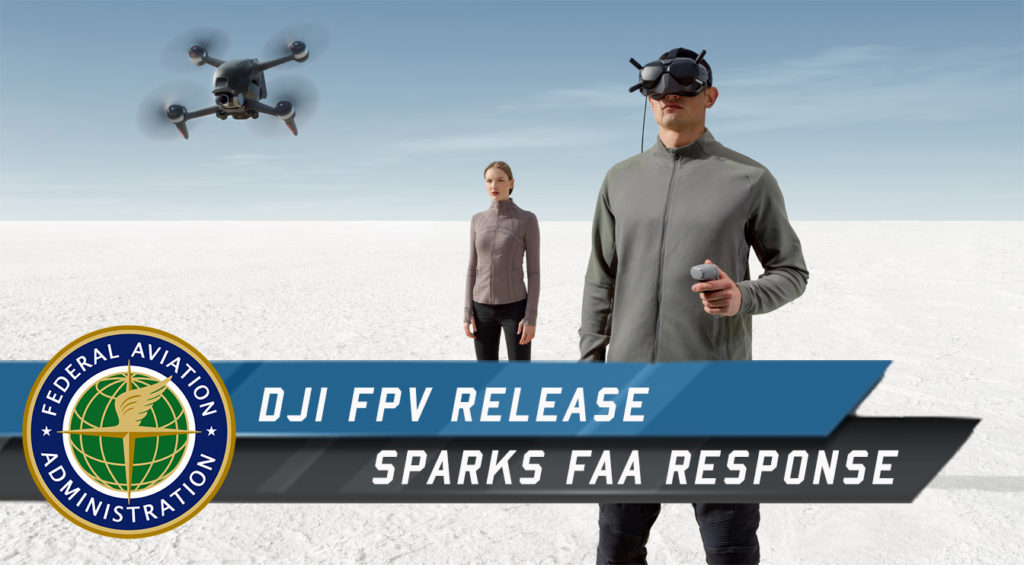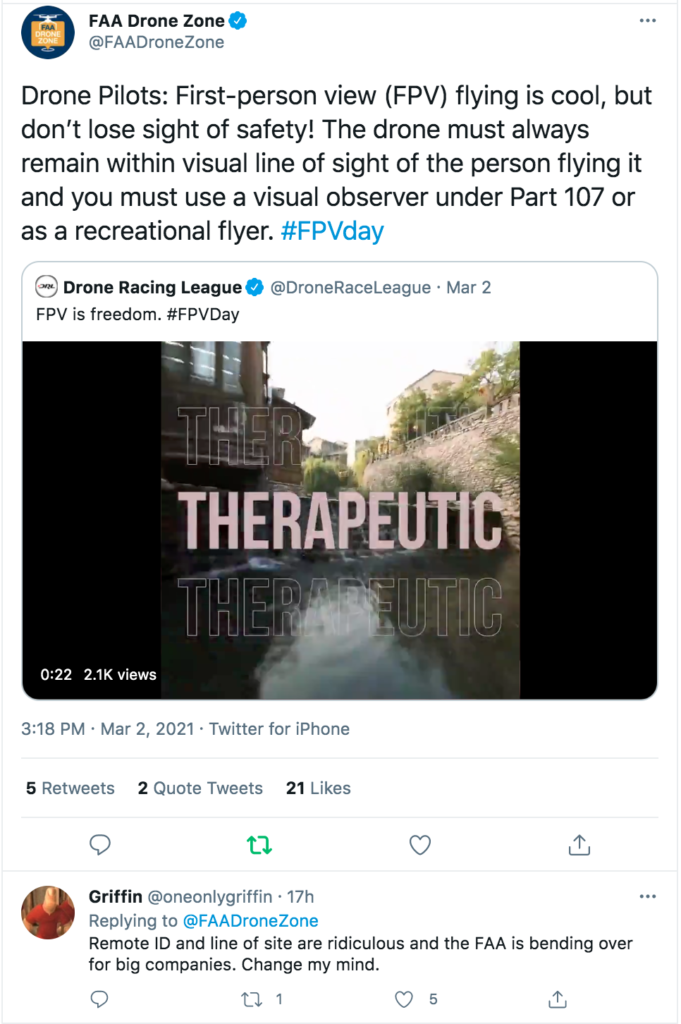
With the release of the DJI FPV drone, youtube videos have sparked the FAA response to remind pilots of flight rules.
DJI’s release of the FPV drone stirred a mixed response from the drone industry yesterday. Even the FAA noticed the fervor that the release caused. It didn’t take more than an hour for pilots to start raising claims. What is all the hoopla about? While the DJI FPV release sure looks to be successful, the marketing strategy was unique for DJI. Drone pilots have argued the marketing videos might send mix messages. Some worry these videos may promote illegal means of drone flying and setup new pilots to fail. Does it matter?
DJI selected a unique group of Youtube individuals for the DJI FPV marketing push. While few were experienced with drones, there were numerous youtubers chosen by DJI to push the new drone. Now this makes sense to many experienced marketers. The expertise of the marketing person may not be important, but their follower counts are important. While the follower counts are high, the expertise on flying may not be quite as high. Which could potentially problem. When new pilots get hyped up on new products…rules & regulations often get overlooked. No problem for the youtuber, but it could setup new pilots to fail and face enforcement.
(Update: Now most youtubers are pushing viewers to Nurk’s Video, an experienced FPV pilot.)
Pilots were all over forums, the internet and instagram simply questioning many of the videos that were being put out on youtube. We’ve seen tweets stating that “now all youtuber’s are FPV experts.” We’ve also seen tweets asking the FAA to remind the FPV community of what the FAA rules truly state. Like maintaining line of sight with the drone itself. Either way, all the FPV chatter sparks the FAA to release a response.
The FAA put out a statement through their FAA Drone Zone twitter account late yesterday afternoon. The FAA put our a response saying ” Drone Pilots: FPV flying is cool, but don’t lose sight of safety! The drone must always remain within visual line of sight of the person flying it and you must use a visual observer under Part 107 or as a recreational flyer.”

Get your biggest and most common Part 107 questions answered by claiming your FREE Guide Now!
Rules of Flying FPV for Recreational or Commercial Drone pilots.
A question I continue to ask myself as regulations pile on, what is the value of being a recreational pilot? If you don’t live in controlled airspace, recreational pilots can still try out flying. Yet the FAA expects you to understand airspace. Since the FAA has high expectations of recreational pilots that are also required for commercial pilots, why not just become a commercial pilot?
While becoming a commercial pilot may not serve many people, it does force the pilot to learn airspace. Albeit, becoming a Part 107 pilot doesn’t teach you how to fly. Whether people have time to learn Part 107 or not may be irrelevant. The FAA is about to test recreational pilots anyway… why not just earn your commercial certificate? Turn that passion into profit? Maybe more pilots will be thinking about this idea. As the FAA releases their response to the FPV adoption, pilots may consider just going all in.
Whether you’re flying recreationally or commercially the pilot is supposed to maintain visual line of sight of the drone. To put that very clearly, the pilot must be able to see the drone at all times. How can FPV pilots see the drone with goggles on? Easy answer, just use a visual observer. Someone to go flying with. Someone who watches the drone to make sure you’re not approaching danger. To make sure you’re not flying over people. The visual observer can also have you reduce your chances of crashing.
While new pilots may not know the FAA requires recreational pilots to to maintain VLOS. Buying a drone is not like buying a camera. Albeit DJI is further pushing that reality. DJI is making flying FPV easier and easier. Most FPV drones are extremely difficult to fly. DJI added a feature to their FPV drone to make it much easier to fly. Press a button and the drone hovers. Just like all of the other consumer based drones. For normal FPV drones, if a pilot lets off the sticks… they will meet the ground fast. DJI changed this environment of flight.
While DJI has made it easier to buy and fly, pilots are flocking to this new drone. Youtubers are mostly not showcasing the legal means of flying FPV. Which sparked an FAA response and reminder. When flying FPV drones, use a visual observer.
Doesn’t matter if you are recreationally flying or turning your passion into profit. Visual observers will be needed to comply with FAA regulations.
Another question surfaces, will the mass adoption of the DJI FPV drone force the FAA to rethink regulations? Will this drone cause the FAA to focus more on FPV drones or just drop trying to regulate hobbyists as a whole?







Add Your Comment